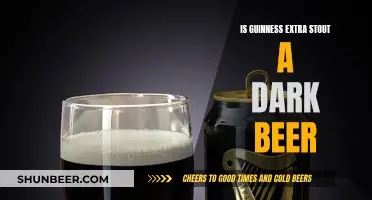
India Pale Ale, or IPA, is a hoppy beer style within the broader category of pale ale. The name comes from the beer's origins as an export beer shipped to India during British colonial times. The beer was brewed with lots of hops to survive long journeys without going bad. The IPA has since evolved into its own unique style, with modern IPAs tending to be around 6-7% ABV. There are many variations of IPAs, including West Coast, New England, and British styles, each with its own distinct flavour profile.
| Characteristics | Values |
|---|---|
| Full Form | India Pale Ale or Indian Pale Ale |
| Origin | British sailors needed a beer that would withstand the long journey from Britain to India |
| Flavour | Hoppy, bitter, fruity, floral, piney, malty, resinous, citrusy, tropical |
| Alcohol Content | Varies, but often higher than other beers |
| ABV Range | 3.6% to 10%+<co: 1,5>/co: 1,5> |
| Variations | <co: 0,2,5>Session, Double/Imperial, Triple, New England, West Coast, East Coast, British, Black, Brut, Milkshake, Belgian, White, India Pale Lager/Cold IPA |
| Serving Temperature | Fresh, cold |
What You'll Learn

History of the IPA
India Pale Ale (IPA) is a hoppy beer style within the broader category of pale ale. The name comes from the beer's status as an export beer shipped to India, which was under the control of the British East India Company until 1858.
The popular origin story of the IPA is that in the late 18th century, George Hodgson, a brewer at the Bow Brewery in East London, began sending his pale ale to India with extra hops and an increased alcohol content. Both the hops and the high alcohol content helped preserve the beer during its long sea journey from England to India. This created a bitter and stronger pale ale that was more refreshing in the hot Indian climate compared to the dark ales and porters popular in London.
However, this story is a simplified version of what really happened. English breweries had been successfully exporting beer to India and farther afield from at least the beginning of the 18th century. By the 1760s, breweries learned that adding extra hops to all of their beers helped fortify them for the voyage to warmer climates. While George Hodgson may not have been the first brewer to come up with the concept, he was the first to achieve a large amount of distribution in India. The Bow Brewery was popular with East India Company traders due to its proximity to the company's docks and Hodgson's liberal credit line of 18 months.
By the early 19th century, "pale ale prepared for the India market" was gaining popularity as exports and hopping levels increased. The first known recorded mention of the phrase "India Pale Ale" came in 1835 in an edition of the Liverpool Mercury. By the 1840s, India Pale Ale had become one of England's best-selling beers. However, its popularity waned by the start of the 20th century as new styles entered the market and taxes on higher-gravity beers increased.
The revival of the IPA came about in the 1970s, thanks to the early beginnings of the craft beer revolution in the United States. American brewers revived the original recipes created 150 years earlier in England while adding new styles of hops. The result was the first examples of American IPAs, which were packed with alcohol and hops. The popularity of IPAs in the US eventually spread back across the Atlantic, and they have since returned to their country of origin and become fashionable once more in Britain.
Guinness Beers: Exploring the Diverse Range of Stouts
You may want to see also

IPA flavour profile
India Pale Ale (IPA) is a style of beer that is characterised by its hop flavour, aroma and bitterness. The flavour profile of an IPA can vary from tropical and fruity to grapefruit-bitter and dry.
IPAs are often associated with the term "hoppy", which is used to describe the sensation in your mouth as the beer washes over your tongue. This sensation can be likened to the difference between the sweetness of strawberries and the bitterness of arugula. However, the word "hoppy" can also refer to the fruity or citrusy flavours and aromas contributed by hops, regardless of the beer's bitterness.
American IPAs, in particular, are known for their aggressive hoppiness, showcasing flavour notes such as citrus, pine, florals, and a strong bitterness. They can range in colour from pale gold to red or copper, and are often divided into East Coast and West Coast styles. West Coast IPAs tend to be more aggressively hoppy and bitter, while East Coast IPAs offer a more balanced profile with a stronger malt presence.
Belgian IPAs, inspired by American IPAs, are another hybrid style that combines the characteristics of American IPAs with Belgian yeast strains. They are typically cloudy, with a dry and assertive bitterness. English IPAs, on the other hand, are less intensely hoppy, with a better balance between malt and hop flavours, and may exhibit toasty and bready malt notes.
The IPA category also includes variations like Imperial (Double) IPAs, Black IPAs, Rye IPAs, and more, each with its own unique flavour profile. Overall, the IPA flavour wheel spans a diverse range of flavours and styles, offering something for every beer enthusiast to enjoy.
The History of IPA Beer: What Does IPA Stand For?
You may want to see also

How to drink an IPA
Drinking an IPA is more than just cracking open a can or bottle and chugging it down. There's an art to drinking an IPA, and it starts with understanding the beer itself.
IPA stands for Indian Pale Ale or India Pale Ale. The story goes that during British colonial times, sailors needed a beer that would survive the long journey from Britain to India. So, they brewed a beer with lots of hops that could survive long journeys without spoiling. And thus, the India Pale Ale was born!
IPAs are known for their hoppy quality, but not all IPAs are the same. They come in a range of styles, including West Coast, New England, Session, British, Double/Imperial, Dry-Hopped, and more. Some are bitter, while others explore the world of fruity flavors. Some have high alcohol content, while others are session beers with less alcohol.
Now that you know a bit about IPAs, here are some tips on how to drink one:
- Use the right glass: While you can certainly drink an IPA straight from the can or bottle, using a glass can enhance the experience. An IPA glass is designed to provide the best aroma and flavor. It has a rippled base that creates agitation with each drink, releasing hop aromatics throughout. The top captures these aromas while providing a wide opening for easy drinking.
- Pour correctly: Hold your glass at a 45-degree angle and begin pouring the beer down the side of the glass until it's about halfway full. Then return the glass to an upright position and continue pouring. This will create a 1- to 1.5-inch head of foam, which helps release aromatics from the hops.
- Temperature matters: IPAs are best enjoyed at a temperature of 45-50 degrees Fahrenheit. If your beer is ice cold, let it sit for a few minutes to warm up slightly before drinking.
- Take your time: Don't chug your IPA! Take small sips and smell the beer between sips to align the aroma and flavor. Drinking slowly also allows the beer to warm up gradually, revealing changes in flavor.
- Pair with food: IPAs can have a high ABV, so take your time and enjoy them with food. They can be a great pairing for a spicy Indian dish or a juicy burger.
- Know your preferences: Not all IPAs will be to your taste. If you don't like bitter beers, try a New England-style IPA, which is less bitter and has intense fruit flavors. If you want lower alcohol content, go for a Session IPA. Experiment with different styles to find your favorites.
Stout and IPA: What's the Difference?
You may want to see also

Different types of IPA
The acronym "IPA" in beer stands for Indian Pale Ale or India Pale Ale. The beer style was originally exported to India during British colonial times. The beer was brewed with lots of hops to help preserve it during the long journey from Britain to India.
Today, there are several types of IPAs, including:
West Coast IPA
Also known as an American IPA, this style was originally crafted in California and is known for its piney aroma with citrus and earthy characteristics. They tend to be less dry but significantly more bitter than other IPAs.
East Coast IPA
A relatively new style, the East Coast IPA differs from West Coast IPAs in that they use mutated, complicated British yeasts, which produce more complex flavours and smells as they ferment the sugar. You will usually detect notes of stone fruit, banana, and tropical fruit. This style is less bitter and cloudier in appearance.
New England IPA
Also known as a hazy IPA, this is the most common type of IPA and is perfect for craft beer newcomers or those who don't usually enjoy the classic hoppy bite of an IPA. It is less bitter and has flavour notes of pineapple, mango, and other bright, sweet flavours.
Double IPA/Imperial IPA
Double and Imperial IPAs are essentially the same thing: IPAs with a higher hop concentration. They have a stronger hop flavour and floral, piney, and citrus notes. The alcohol content is usually over 7%.
Triple IPA
Triple IPAs have an even higher hop flavour and alcohol content, usually over 10% ABV. They are very popular, with people queuing for hours to get their hands on them.
Session IPA
Session IPAs are lighter in body and alcohol content (below 5% ABV) compared to traditional IPAs, but still pack a strong hoppy aroma. They are brewed for casual drinking sessions, allowing you to enjoy multiple beers in one sitting.
Black IPA
Also known as a Cascadian Dark Ale, Black IPAs are brewed to look like a stout but have the hoppy aroma of a typical IPA. The darker malts lend roasted flavours that contrast with the floral, citrus, and piney flavours of the hops.
Belgian IPA
Belgian IPAs tend to be lighter in colour and have a more complex flavour and higher alcohol content than a typical IPA. The driving flavour comes from Belgian yeast, which provides sweet, bready, and warm notes.
Fruited IPA
This style of IPA has become so popular that it warrants its own category. The aroma, flavour, and acidity largely come from grapefruit, amplifying the bitterness of the beer.
Milkshake IPA/Lactose IPA
Also known as cream IPAs, these beers get their nickname from the sweetness that lactose (milk sugar) adds to the beer. They often include fruit or vanilla, and have a low carbonation, resulting in a smooth and creamy mouthfeel.
The Cost of Guinness Beer in Ireland
You may want to see also

How to choose an IPA
India Pale Ale, or IPA, is a hoppy beer style within the broader category of pale ales. The style was originally invented in Britain during colonial times. British sailors were looking for a beer recipe that would be easy to preserve on long trips from Britain to India. Thus, the India Pale Ale was born. The beer has come a long way since colonial times, but the hoppy quality has mostly remained the same.
Know the Different Styles
IPAs come in a range of styles, including West Coast, New England, East Coast, British, Belgian, and more. Each style has its own unique characteristics and flavour profiles. Knowing the different styles will help you choose an IPA that suits your taste preferences.
Consider the Bitterness Level
Not all IPAs are overly bitter. While traditional British IPAs tend to be bitter, modern IPAs often explore the world of fruity flavours that can be derived from hops. If you prefer less bitterness in your beer, look for styles such as New England IPAs, which are known for their extremely low bitterness and intense fruity flavours.
Alcohol Content
IPAs are known for having a high alcohol content, but this is not always the case. Session IPAs, for example, have a lower alcohol content, typically below 5% ABV. On the other hand, Double or Imperial IPAs have a higher alcohol content, usually over 7% ABV. Choose an IPA that aligns with your desired level of intoxication.
Hop Characteristics
Familiarise yourself with hop characteristics to further refine your IPA choices. For instance, dry-hopped IPAs have an extremely strong aroma without adding any bitterness. Single-hopped IPAs use only one type of hop, while other IPAs combine different hops to create a variety of flavours.
Freshness
For the optimal IPA experience, it is recommended to consume the beer within the first three weeks of production. While it may not be harmful to drink an IPA four to five weeks after production, the quality and flavour may start to deteriorate.
Pairing
Consider pairing your IPA with food. IPAs can have strong flavours and high alcohol content, so pairing them with the right food can enhance your drinking experience.
In conclusion, when choosing an IPA, it is important to consider factors such as style, bitterness level, alcohol content, hop characteristics, freshness, and food pairings. By taking these factors into account, you can find an IPA that suits your taste preferences and drinking occasion.
Guinness: The Healthiest Beer Option?
You may want to see also
Frequently asked questions
IPA stands for Indian Pale Ale or India Pale Ale.
The IPA was originally an export beer shipped to India during British colonial times. Sailors needed a beer that would survive the long journey and brewed a beer with lots of hops that acted as a preservative.
The ABV of an IPA depends on the type. Some IPAs have a lower ABV of around 5% while others are brewed differently and have an ABV of 7% or more.
IPAs are known for their bitter quality and higher than average amount of hops. They also have fruit and citrus notes, such as grapefruit and orange, and earthier notes like pine.
An IPA is hoppier and bolder than a pale ale. If a pale ale is tabasco sauce, an IPA is a habanero hot sauce.







